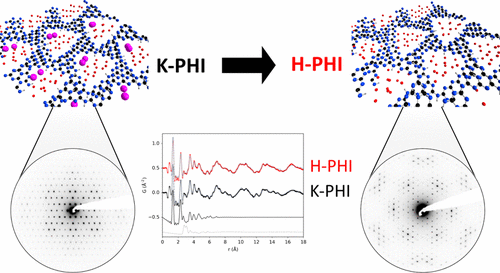当前位置:
X-MOL 学术
›
Chem. Mater.
›
论文详情
Our official English website, www.x-mol.net, welcomes your
feedback! (Note: you will need to create a separate account there.)
Structural Insights into Poly(Heptazine Imides): A Light-Storing Carbon Nitride Material for Dark Photocatalysis
Chemistry of Materials ( IF 7.2 ) Pub Date : 2019-08-26 , DOI: 10.1021/acs.chemmater.9b02199 Hendrik Schlomberg 1, 2, 3 , Julia Kröger 1, 2, 3 , Gökcen Savasci 1, 2, 3 , Maxwell W. Terban 1 , Sebastian Bette 1 , Igor Moudrakovski 1 , Viola Duppel 1 , Filip Podjaski 1 , Renée Siegel 4 , Jürgen Senker 4 , Robert E. Dinnebier 1 , Christian Ochsenfeld 2, 3 , Bettina V. Lotsch 1, 2, 3
Chemistry of Materials ( IF 7.2 ) Pub Date : 2019-08-26 , DOI: 10.1021/acs.chemmater.9b02199 Hendrik Schlomberg 1, 2, 3 , Julia Kröger 1, 2, 3 , Gökcen Savasci 1, 2, 3 , Maxwell W. Terban 1 , Sebastian Bette 1 , Igor Moudrakovski 1 , Viola Duppel 1 , Filip Podjaski 1 , Renée Siegel 4 , Jürgen Senker 4 , Robert E. Dinnebier 1 , Christian Ochsenfeld 2, 3 , Bettina V. Lotsch 1, 2, 3
Affiliation

|
Solving the structure of carbon nitrides has been a long-standing challenge due to the low crystallinity and complex structures observed within this class of earth-abundant photocatalysts. Herein, we report on two-dimensional layered potassium poly(heptazine imide) (K-PHI) and its proton-exchanged counterpart (H-PHI), obtained by ionothermal synthesis using a molecular precursor route. We present a comprehensive analysis of the in-plane and three-dimensional structure of PHI. Transmission electron microscopy and solid-state NMR spectroscopy, supported by quantum-chemical calculations, suggest a planar, imide-bridged heptazine backbone with trigonal symmetry in both K-PHI and H-PHI, whereas pair distribution function analyses and X-ray powder diffraction using recursive-like simulations of planar defects point to a structure-directing function of the pore content. While the out-of-plane structure of K-PHI exhibits a unidirectional layer offset, mediated by hydrated potassium ions, H-PHI is characterized by a high degree of stacking faults due to the weaker structure directing influence of pore water. Structure–property relationships in PHI reveal that a loss of in-plane coherence, materializing in smaller lateral platelet dimensions and increased terminal cyanamide groups, correlates with improved photocatalytic performance. Size-optimized H-PHI is highly active toward photocatalytic hydrogen evolution, with a rate of 3363 μmol/gh H2 placing it on par with the most active carbon nitrides. K- and H-PHI adopt a uniquely long-lived photoreduced polaronic state in which light-induced electrons are stored for more than 6 h in the dark and released upon addition of a Pt cocatalyst. This work highlights the importance of structure–property relationships in carbon nitrides for the rational design of highly active hydrogen evolution photocatalysts.
中文翻译:

聚(庚嗪酰亚胺)的结构见解:一种用于暗光催化的储光氮化碳材料
由于在这类富含地球的光催化剂中观察到的低结晶度和复杂的结构,解决碳氮化物的结构一直是一项长期的挑战。在本文中,我们报道了通过分子前驱体路线通过离子热合成获得的二维分层聚庚二酰亚胺钾(K-PHI)及其质子交换的对应物(H-PHI)。我们对PHI的平面和三维结构进行了全面的分析。由量子化学计算支持的透射电子显微镜和固态NMR光谱表明,在K-PHI和H-PHI中,具有三角形对称性的平面,酰亚胺桥联的庚嗪主链,而使用平面缺陷的类似递归模拟的结对分布函数分析和X射线粉末衍射则指向孔隙含量的结构定向函数。尽管K-PHI的平面外结构表现出单方向的层偏移,这是由水合的钾离子介导的,但H-PHI的特征是由于孔隙结构对孔隙水的影响较弱而导致的堆积层错程度很高。PHI中的结构-性质关系表明,平面内相干性的丧失(在较小的侧向血小板尺寸中实现)和增加的末端氰酰胺基团,与光催化性能的提高相关。尺寸优化的H-PHI对光催化氢的释放具有很高的活性,速率为3363μmol/ gh H 尽管K-PHI的平面外结构表现出单方向的层偏移,这是由水合的钾离子介导的,但H-PHI的特征是由于孔隙结构对孔隙水的影响较弱而导致的堆积层错程度很高。PHI中的结构-性质关系表明,在较小的侧向血小板尺寸和增加的末端氰酰胺基团中发生的面内相干性损失与改善的光催化性能有关。尺寸优化的H-PHI对光催化氢的释放具有很高的活性,速率为3363μmol/ gh H 尽管K-PHI的平面外结构表现出单方向的层偏移,这是由水合的钾离子介导的,但H-PHI的特征是由于孔隙结构对孔隙水的影响较弱而导致的堆积层错程度很高。PHI中的结构-性质关系表明,平面内相干性的丧失(在较小的侧向血小板尺寸中实现)和增加的末端氰酰胺基团,与光催化性能的提高相关。尺寸优化的H-PHI对光催化氢的释放具有很高的活性,速率为3363μmol/ gh H 在较小的侧向血小板尺寸和增加的末端氰酰胺基团中实现,与改善的光催化性能有关。尺寸优化的H-PHI对光催化氢的释放具有很高的活性,速率为3363μmol/ gh H 在较小的侧向血小板尺寸和增加的末端氰酰胺基团中实现,与改善的光催化性能有关。尺寸优化的H-PHI对光催化氢的释放具有很高的活性,速率为3363μmol/ gh H2将其与活性最高的碳氮化物并列。K-和H-PHI采用独特的长寿命光还原极化子态,其中光诱导的电子在黑暗中存储6小时以上,并在添加Pt助催化剂后释放。这项工作强调了氮化碳中结构与性质之间的关系对于高活性氢析出光催化剂的合理设计的重要性。
更新日期:2019-08-27
中文翻译:

聚(庚嗪酰亚胺)的结构见解:一种用于暗光催化的储光氮化碳材料
由于在这类富含地球的光催化剂中观察到的低结晶度和复杂的结构,解决碳氮化物的结构一直是一项长期的挑战。在本文中,我们报道了通过分子前驱体路线通过离子热合成获得的二维分层聚庚二酰亚胺钾(K-PHI)及其质子交换的对应物(H-PHI)。我们对PHI的平面和三维结构进行了全面的分析。由量子化学计算支持的透射电子显微镜和固态NMR光谱表明,在K-PHI和H-PHI中,具有三角形对称性的平面,酰亚胺桥联的庚嗪主链,而使用平面缺陷的类似递归模拟的结对分布函数分析和X射线粉末衍射则指向孔隙含量的结构定向函数。尽管K-PHI的平面外结构表现出单方向的层偏移,这是由水合的钾离子介导的,但H-PHI的特征是由于孔隙结构对孔隙水的影响较弱而导致的堆积层错程度很高。PHI中的结构-性质关系表明,平面内相干性的丧失(在较小的侧向血小板尺寸中实现)和增加的末端氰酰胺基团,与光催化性能的提高相关。尺寸优化的H-PHI对光催化氢的释放具有很高的活性,速率为3363μmol/ gh H 尽管K-PHI的平面外结构表现出单方向的层偏移,这是由水合的钾离子介导的,但H-PHI的特征是由于孔隙结构对孔隙水的影响较弱而导致的堆积层错程度很高。PHI中的结构-性质关系表明,在较小的侧向血小板尺寸和增加的末端氰酰胺基团中发生的面内相干性损失与改善的光催化性能有关。尺寸优化的H-PHI对光催化氢的释放具有很高的活性,速率为3363μmol/ gh H 尽管K-PHI的平面外结构表现出单方向的层偏移,这是由水合的钾离子介导的,但H-PHI的特征是由于孔隙结构对孔隙水的影响较弱而导致的堆积层错程度很高。PHI中的结构-性质关系表明,平面内相干性的丧失(在较小的侧向血小板尺寸中实现)和增加的末端氰酰胺基团,与光催化性能的提高相关。尺寸优化的H-PHI对光催化氢的释放具有很高的活性,速率为3363μmol/ gh H 在较小的侧向血小板尺寸和增加的末端氰酰胺基团中实现,与改善的光催化性能有关。尺寸优化的H-PHI对光催化氢的释放具有很高的活性,速率为3363μmol/ gh H 在较小的侧向血小板尺寸和增加的末端氰酰胺基团中实现,与改善的光催化性能有关。尺寸优化的H-PHI对光催化氢的释放具有很高的活性,速率为3363μmol/ gh H2将其与活性最高的碳氮化物并列。K-和H-PHI采用独特的长寿命光还原极化子态,其中光诱导的电子在黑暗中存储6小时以上,并在添加Pt助催化剂后释放。这项工作强调了氮化碳中结构与性质之间的关系对于高活性氢析出光催化剂的合理设计的重要性。


















































 京公网安备 11010802027423号
京公网安备 11010802027423号